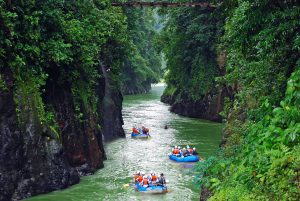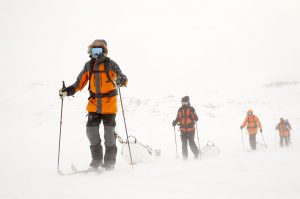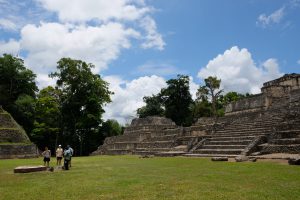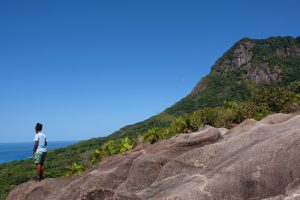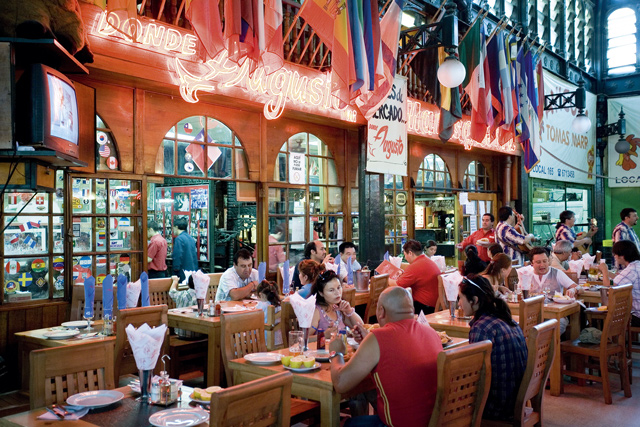
Chile is a long, sliver of a country — just over 2,500 miles long, to be precise — hemmed on one side by the rocky backbone of the Andes and on the other by the Pacific Ocean. Santiago sits in a valley surrounded by snow-capped mountains, plumb in the middle of the country. Historically it’s been overlooked as a destination in its own right, used instead as a stopover for domestic flights to the dramatic Atacama Desert in the north, the wine valleys of the central region, the windswept Patagonian south, or archaeologically rich Easter Island.
But a seismic shift in recent years has seen the capital shake off its reputation as a poor man’s Buenos Aires. In the years since 1990, when the country returned to democracy after Augusto Pinochet’s 15-year military dictatorship, the food, music and art scene has flourished — getting into its stride in recent years following investment in hotels, fine dining and museums. Tourists today enjoy colorful, clean neighborhoods decorated with murals; great infrastructure; live music and world-class, international cuisine seven days a week — plus local markets, street food and unique traditions.
In addition, the tourism board is holding out its arms to visitors. Arrivals from the United States saw an increase of 18 percent in the first half of 2016 when compared to the previous year, with 107,265 North American tourists visiting between January and June. Up until 2014, US citizens were charged a $160 reciprocity fee, but today travelers don’t need to obtain a visa before travel to Chile, and are issued a free Tourist Card upon arrival, which is valid for 90 days.
Chile is Spanish-speaking and, for those who do speak the language, be warned that the distinctive Chilean accent may take a few days to acclimatize to. The best time to visit Santiago, weather-wise, is during the warmer Southern Hemisphere months, between late-September and May — although crowds and hotel prices do swell. Winter sees some rainfall and increased smog levels, although the snow coating the Andes beckons skiers. Fall (March to May) sees the wine harvest; and if you wish to experience Chilean fondas (outdoor parties), asados (barbecues) and traditional cueca dancing, visit in the week leading up to Fiestas Patrias on September 18 each year.
Day 1
Morning: Start your day with panoramic views of the city and Andean Cordillera from the top of Cerro San Cristobal. Reach the base of the hill by walking through the colorful Bellavista neighborhood; from there, walk up the footpath (one hour to the top) or jump on the funicular. At the top, buy a mote con huesillo — a sweet, chilled drink of peach juice and wheat. The hill also offers a spectacular pool, open in the summer months, and a zoo. parquemet.cl
Afternoon: Back down in Bellavista, pause for a traditional Chilean lunch at Galindo, sampling dishes like pastel de choclo (corn and mince pie) or cazuela stew. Next, visit Chilean Nobel-laureate Pablo Neruda’s house, La Chascona. Take a tour through the eclectically designed house for a glimpse of the 20th-century poet’s life and snapshots of bohemian Santiago. If there’s time, take in the area’s famous street art on hire bike, or with a private photography tour with FotoRuta. galindo.cl fundacionneruda.org labicicletaverde.com foto-ruta.com
Evening: Pio Nono street in Bellavista is the beating heart of the city’s nightlife; stick around to carouse in large drinking halls, frequented by live bands, and snack on street food such as sopaipillas (traditional fried pastries); or go to Patio Bellavista to browse souvenirs, then try bespoke cocktails at Red. patiobellavista.cl
Day 2
Morning: Check out Plaza de Armas — the main square — with its grand cathedral and imposing colonial buildings. This is the administrative center; a few blocks south stands La Moneda — the former mint turned presidential palace. The latter isn’t generally open to the public; however, on the corner of the main square is Museo Chileno de Arte Precolombino — a stunning museum showcasing the country’s indigenous art. precolombino.cl
Afternoon: After a seafood lunch in the atmospheric central courtyard of Mercado Central — a beautiful stone and wrought-iron edifice, and still a working fish market — head across the river into the hectic La Vega market area. It’s the lesser-seen, less-cosmopolitan side of the city: chaotic warehouses selling fresh produce and workers dining at myriad pop-up cantinas (bars). From here, jump in a taxi to either the Museo de la Memoria y los Derechos Humanos — a fantastic museum, opened in 2010, that commemorates the victims of human rights violations during Augusto Pinochet’s regime between 1973 and 1990 — or the Cementerio General, the romantic, rambling resting place of Chilean heroes including Nobel-laureate Gabriela Mistral and folk musician Victor Jara. museodelamemoria.cl
Evening: Spend the evening in the chic Lastarria neighborhood, home to high-end hotels like The Singular (check out the rooftop bar) and a cultural hub with arthouse cinemas and theaters. Before the sun sets, stroll the pathways of the leafy Cerro Santa Lucia where you can learn about the city’s founder, conquistador Pedro de Valdivia. Then, browse antiques stalls on the eponymous Lastarria street before trying one of the city’s best pisco sours at Chipe Libre. For elegant wine and food pairings, head to trendy bar Bocanariz. bocanariz.cl
Day 3
Morning: Take the coach to the coastal gem of Valparaiso — 75 miles west of the capital, and a UNESCO World Heritage Site. Tour its jumble of rickety funiculars and colorful buildings, many adorned with magical murals. Head down to the main harbor, and take a tour of the coast on a rustic fishing boat, stopping off at floating pontoons to admire the lazy sea lions.
Afternoon: After snacking on delicious seafood empanadas (try Delicias Express, near the main plaza, Sotomayor), either take a local bus along the coast to the sandy beaches of Viña del Mar (known as ‘The Garden City’) to go sunbathing, or climb uphill in Valparaiso to visit another distinctive and historic Neruda property, La Sebastiana. fundacionneruda.org
Evening: If you choose to stay in Valparaiso, head out for dinner at the locally beloved Cafe Vinilo for wholesome food in a rustic setting, or to Cafe Turri for an international menu and beautiful sea views. For a seriously upmarket dinner, splash out at Apice Cocina de Mar. If you’re back in Santiago, try ‘ancestral’ food at Peumayen in Bellavista. turri.cl restaurantapice.cl peumayenchile.cl
How to get there
Flights: Santiago’s Comodoro Arturo Merino Benítez International Airport (SCL) is located nine miles north west of the city center, accessed by a shuttle or taxi. Direct flights to Santiago can be taken from Atlanta, Dallas, Houston, Miami and New York, with airlines including Delta, United, American and LATAM.
Getting around: The city’s yellow-and-black taxis are a safe and affordable way to get around the city. As is the metro: it’s crowded but modern and efficient, and you can use a contactless Bip! Card, bought from any station,
to top up and swipe in and out of the system. Two people can share a card, and they can also be used on the Transantiago bus system.
Where to stay
The Aubrey: This elegant 15-room hotel in the heart of the bohemian Bellavista neighborhood was originally built as a family mansion in 1927. Following a loving restoration, it opened its doors in 2010 as Santiago’s first true boutique hotel. Most rooms have private patios, and the outdoor pool has views of the landscaped Cerro San Cristobal. theaubrey.com
Matildas Hotel Boutique: Located in the Barrio Brasil area with elegant — if slightly dilapidated — colonial buildings, currently popular with artists, this 17-room boutique hotel in an elegant turn-of-the-century townhouse has a breakfast terrace that looks out over a small garden. matildashotel.com
Casa Galos Hotel and Lofts: Located on Valparaiso’s most scenic hill, Cerro Alegre, Casa Galos has nine beautiful rooms and six cosy apartments that afford spectacular views over the city. The historic premises, dating to 1885, was stylishly refurbished in 2012, and service is famously warm and friendly. casagalos.cl
Published in the Winter 2017/18 issue of ASTA Network





